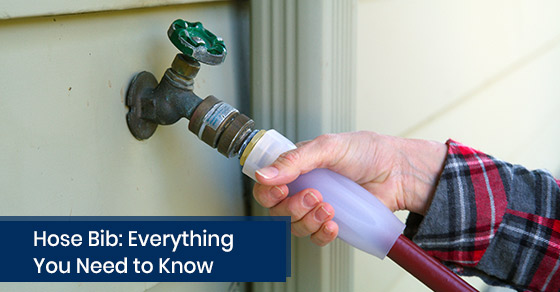Hose Bib: Everything You Need to Know

Many property owners find pleasure in utilizing their outdoor spaces during the summer. Whether it is their backyard, patio, or front yard, taking advantage of exterior living spaces is necessary during warmer months. Outdoor activities such as BBQs or filling the pool with the garden hose for water activities are just some of the entertainments that happen outdoors.
A hose bib has a variety of names and is also known as a spigot. It is a small outdoor faucet that is typically attached to the side or back of a home. It is known as an external faucet, which is often installed for the homeowner’s convenience and facilitates the use of water outside of the home. However, much like any other faucet, it is susceptible to wear and tear. We will offer information on everything you need to know for outdoor plumbing or to acquire more details about your hose bib.
Benefits of Having a Hose Bib
Outdoor plumbing is quite beneficial. A hose bib offers significant advantages. It minimizes the need for moving back and forth to bring water from inside the home outside. It makes spending time outdoors more enjoyable and livable. Some individuals use outdoor faucets for a variety of reasons. These can include some of the following:
- Watering the lawn and flowerbeds
- Cleansing hands and feet of dirt
- Washing the car
- Giving your dog a good scrub
- Refilling your pool
Although not limited to this list, a hose bib offers a plethora of other uses. Many individuals use it in a variety of ways. To keep a hose bib in tip-top shape, though, they require maintenance. Proper upkeep keeps them running efficiently throughout the summer, but most importantly during the winter. Hose bibs are typically susceptible to freezing during the cold winter months. When this occurs, cracked pipes and water damage can ensue.
How does a hose bib function?
Your plumbing system in your home is connected to your hose bib. For some, it is merely a spigot that protrudes on the outside. However, there is more to this spigot. It is attached to your indoor water supply. This attachment permits water to flow from inside of the home outside. Pipes extend from the end of the hose bib to the main supply of water indoors.
The issue several homeowners face, particularly in the winter, is the proximity of the valve to the exterior of their property. The problem this presents is that the valve remains too close to the home.
When water freezes in the taps and pipes, it expands, which can lead to bursting and damage to your house. In some homes, there is a separate valve that aids in preventing this pipe from freezing. This valve is often located in the basement or another convenient location closer to the hose bib. However, a separate shut-off valve is sometimes not enough to eradicate the potential ruin that can occur.
Preventing Your Hose Bib from Freezing
A plumbing emergency occurs when a hose bib freezes. It will not only cause water to spray into the home, but also impact electrical wires and other pertinent features of the house. The worst thing anyone would want to experience is a home flooded with water. Fortunately, there are some steps homeowners can take to decrease the chance of their hose bib freezing.
Consider winterizing your hose bib. Disconnecting your garden hose and draining both the hose and the pipe can reduce the chance of your hose bib freezing. Not performing this action can trap the water in the spigot, preventing it from draining and increasing the likelihood of freezing.
Furthermore, turning off the valve that provides water to the hose bib and leaving the spigot of the hose bib open during winter is also beneficial. Additionally, filling gaps around the exterior of your home where the pipe resides can help minimize freezing.
The best option is to install a frost-free hose bib. Although traditional and frost-free hose bibs appear to be relatively the same, there is a slight variance in their appearance. The frost-free bib extends further from the exterior of the home. However, the soundest difference is evident within the house, where the shut-off valve for this pipe resides. Unlike traditional hose bibs, though, a long metal valve tube stretches further into the home where it is much warmer.
For outdoor plumbing, we recommend contacting a plumbing expert to assist with installing a frost-free hose bib. Considering this hose bib offers increased safety. It protects your home from potential water damage.
What should I do if my hose bib freezes?
Water does not flow from a hose bib when it is frozen. When this freezing occurs, thawing out the hose bib is the solution. Leaving the faucet open, wrapping the base of the pipe with old rags, and soaking them with boiling water can melt the frozen water. Doing this repeatedly until the water drains is crucial. However, we always recommend professional help.
Be sure to contact professionals for your outdoor plumbing. By acquiring such services, these experts can help you install the correct plumbing components for your hose bib. The frost-free hose bib is particularly the ideal solution for preventing freezing.
Don’t Neglect Your Hose Bib—Contact Brothers Plumbing
Due to the size of the hose bib, or how often it may or may not be used, it can sometimes be disregarded by homeowners. Consequently, they are susceptible to freezing and leading to unwanted pipe bursts and floods for homeowners. Fortunately, with the right maintenance and professional upkeep from experts with decades of experience, Brothers Plumbing can help.
We will provide you with all of the care and assistance you need to keep your outdoor plumbing in excellent shape. For more information on how we can help, contact us.
Posted By Brothers Plumbing
0 Comment
